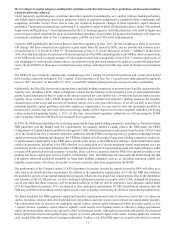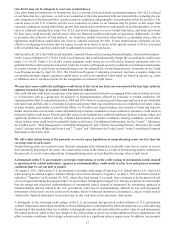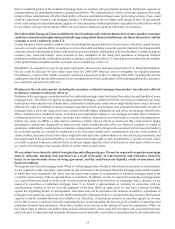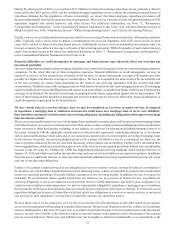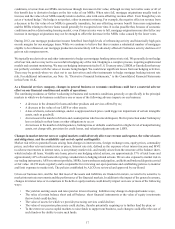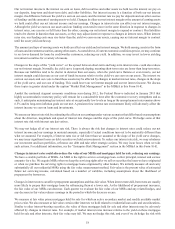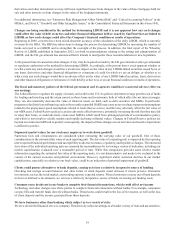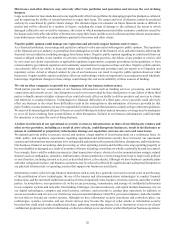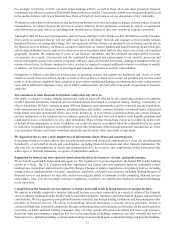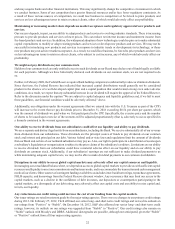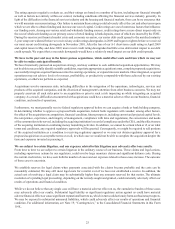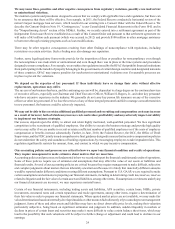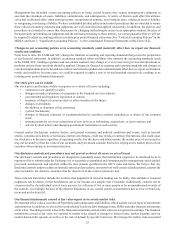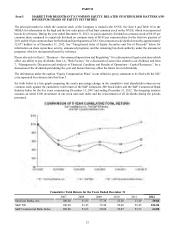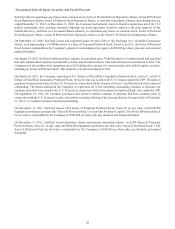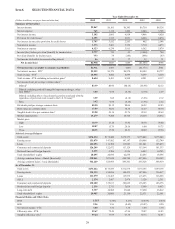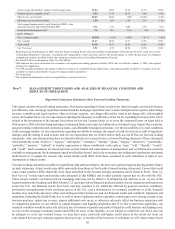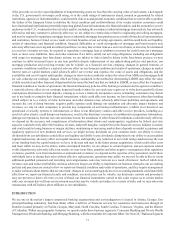SunTrust 2012 Annual Report Download - page 37
Download and view the complete annual report
Please find page 37 of the 2012 SunTrust annual report below. You can navigate through the pages in the report by either clicking on the pages listed below, or by using the keyword search tool below to find specific information within the annual report.21
For example, in October of 2012, our main online banking website, as well as those of several other prominent financial
institutions, was subject to a series of Distributed Denial of Service Attacks. These attacks, which were also generally publicized
in the media, did not result in any financial loss, fraud or breach of client data or service disruptions of any materiality.
Third parties with whom we do business or that facilitate our business activities, including exchanges, clearing houses, financial
intermediaries, or vendors that provide services or security solutions for our operations, could also be sources of operational
and information security risk to us, including from breakdowns or failures of their own systems or capacity constraints.
Although to date we have not experienced any material losses relating to cyber attacks or other information security breaches,
there can be no assurance that we will not suffer such losses in the future. Our risk and exposure to these matters remains
heightened because of, among other things, the evolving nature of these threats, our prominent size and scale, and our role in
the financial services industry, our plans to continue to implement our internet banking and mobile banking channel strategies
and develop additional remote connectivity solutions to serve our clients when and how they want to be served, our expanded
geographic footprint, the outsourcing of some of our business operations, and the continued uncertain global economic
environment. As a result, cybersecurity and the continued development and enhancement of our controls, processes and
practices designed to protect our systems, computers, software, data and networks from attack, damage or unauthorized access
remain a focus for us. As threats continue to evolve, we may be required to expend additional resources to continue to modify
or enhance our protective measures or to investigate and remediate information security vulnerabilities.
Disruptions or failures in the physical infrastructure or operating systems that support our businesses and clients, or cyber
attacks or security breaches of the networks, systems or devices that our clients use to access our products and services could
result in client attrition, regulatory fines, penalties or intervention, reputational damage, reimbursement or other compensation
costs, and/or additional compliance costs, any of which could materially adversely affect our results of operations or financial
condition.
The soundness of other financial institutions could adversely affect us.
Our ability to engage in routine funding transactions could be adversely affected by the actions and commercial soundness
of other financial institutions. Financial services institutions are interrelated as a result of trading, clearing, counterparty, or
other relationships. We have exposure to many different industries and counterparties, and we routinely execute transactions
with counterparties in the financial industry, including brokers and dealers, commercial banks, investment banks, mutual and
hedge funds, and other institutional clients. As a result, defaults by, or even rumors or questions about, one or more financial
services institutions, or the financial services industry generally, in the past have led to market-wide liquidity problems and
could lead to losses or defaults by us or by other institutions. Many of these transactions expose us to credit risk in the event
of default of our counterparty or client. In addition, our credit risk may be exacerbated when the collateral held by us cannot
be realized or is liquidated at prices not sufficient to recover the full amount of the financial instrument exposure due us. There
is no assurance that any such losses would not materially and adversely affect our results of operations.
We depend on the accuracy and completeness of information about clients and counterparties.
In deciding whether to extend credit or enter into other transactions with clients and counterparties, we may rely on information
furnished by or on behalf of clients and counterparties, including financial statements and other financial information. We
also may rely on representations of clients and counterparties as to the accuracy and completeness of that information and,
with respect to financial statements, on reports of independent auditors.
Regulation by federal and state agencies could adversely affect the business, revenue, and profit margins.
We are heavily regulated by federal and state agencies. This regulation is to protect depositors, the federal DIF and the banking
system as a whole. The U.S. Congress and state legislatures and federal and state regulatory agencies continually review
banking laws, regulations, and policies for possible changes. Changes to statutes, regulations, or regulatory policies, including
interpretation or implementation of statutes, regulations, or policies, could affect us adversely, including limiting the types of
financial services and products we may offer and/or increasing the ability of nonbanks to offer competing financial services
and products. Also, if we do not comply with laws, regulations, or policies, we could receive regulatory sanctions and damage
to our reputation.
Competition in the financial services industry is intense and could result in losing business or margin declines.
We operate in a highly competitive industry that could become even more competitive as a result of reform of the financial
services industry resulting from the Dodd-Frank Act and other legislative, regulatory and technological changes, and continued
consolidation. We face aggressive competition from other domestic and foreign lending institutions and from numerous other
providers of financial services. The ability of nonbanking financial institutions to provide services previously limited to
commercial banks has intensified competition. Because nonbanking financial institutions are not subject to the same regulatory
restrictions as banks and bank holding companies, they can often operate with greater flexibility and lower cost structures.
Securities firms and insurance companies that elect to become financial holding companies, can offer virtually any type of
financial service, including banking, securities underwriting, insurance (both agency and underwriting) and merchant banking,


